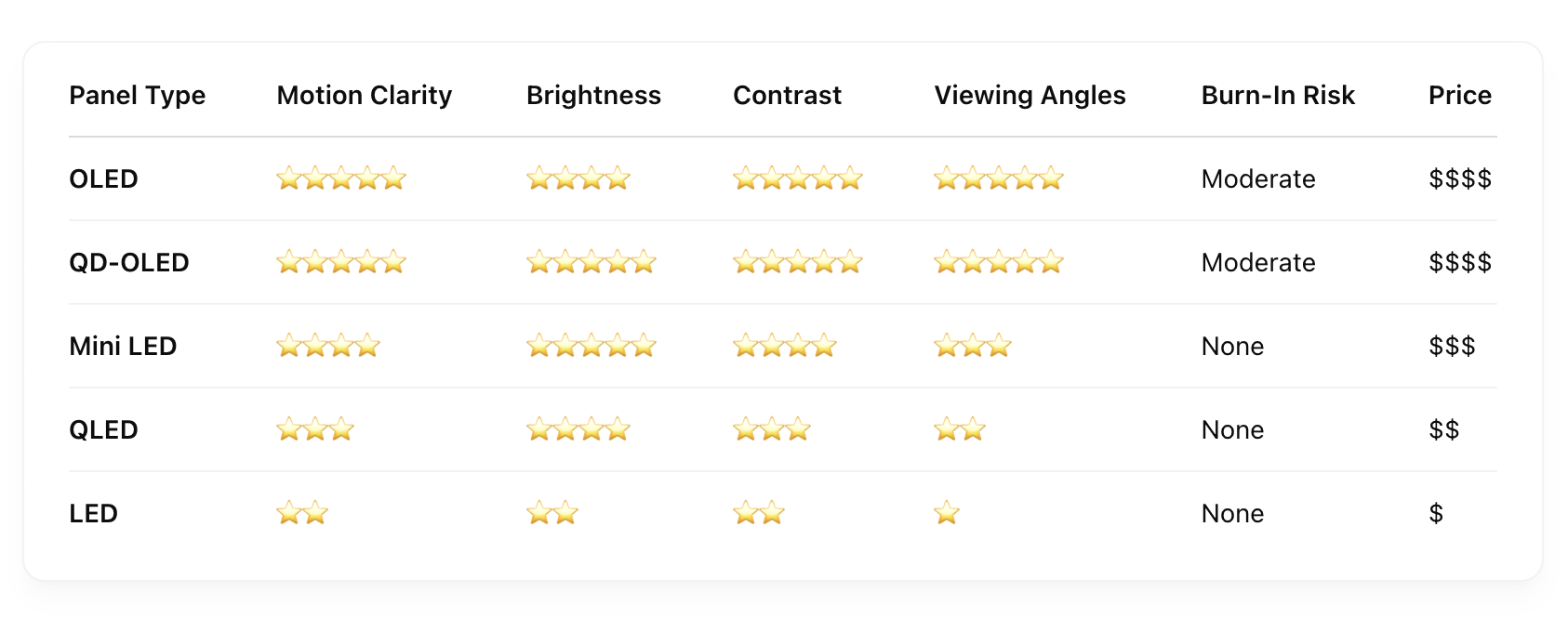What's the Best TV For Watching Live Hockey in 2025?
🏒 How to Choose the Best TV for Watching Hockey with Razor-Sharp Clarity
If you’re a die-hard hockey fan, you know how fast the game moves. Between lightning-quick passes, slap shots, and puck chases along the boards, clarity is everything. The right TV can make the difference between losing the puck on screen—or feeling like you're in the rink.
In this guide, we’ll break down what to look for in a TV that keeps up with hockey’s speed, so you don’t miss a single moment of the action.
🎯 1. Motion Clarity is King
Why it matters:
Hockey is one of the fastest sports out there. A puck can fly across the screen in a blur unless your TV handles motion well.
What to look for:
High Refresh Rate (120Hz or higher): This ensures smoother motion and helps eliminate motion blur.
Low Response Time: This is the time it takes for pixels to change color. Lower is better.
Good Motion Processing: Look for TVs with features like “MotionFlow,” “Motion Smoothing,” or “Black Frame Insertion” (but be careful—some can introduce the "soap opera effect").
✅ Best picks: OLED and high-end QLED or Mini LED TVs with 120Hz native refresh rate
🏁 2. Contrast and Brightness Help You Track the Puck
Why it matters:
That tiny black puck on white ice can easily get lost if your TV can’t deliver strong contrast or gets washed out in bright rooms.
What to look for:
High Contrast Ratio: Deep blacks and bright whites help define the puck and players.
High Peak Brightness: Especially useful if you watch with lights on or in daylight.
Local Dimming: Helps maintain detail in dark and bright areas simultaneously.
✅ Best picks: OLED for perfect blacks, Mini LED or QD-OLED for brightness and clarity
👀 3. Size and Viewing Angles
Why it matters:
Hockey is a team sport, and chances are, you’re watching with others. Viewing angle and screen size make a huge difference in group settings.
What to look for:
Bigger Screen (at least 55"+): Lets you see fine details like jersey numbers and puck position
Wide Viewing Angles: Ensures everyone sees the same sharp picture, even off-center
✅ Best picks: OLED and QD-OLED have excellent viewing angles; QLED and Mini LED vary
🎮 4. Input Lag? Only If You’re Gaming
If you're only watching hockey and not playing NHL 24 on your console, you don't have to worry much about input lag. Still, newer TVs with Game Mode can improve responsiveness for both gamers and live sports.
🧪 5. Panel Technology Showdown
Here’s a quick ranking of panel types specifically for hockey viewing:
🏆 Top Recommended TVs for Hockey in 2025
Here are a few current models that knock it out of the park (or rink):
LG OLED G5 or C4 (C5 coming soon) – Elite motion handling and infinite contrast, a fan favorite for fast-paced sports
Samsung S90F / S95F (QD-OLED) – Combines OLED blacks with QD-layer for vibrant colors
Sony A95 or Bravia A Mark II – Fantastic motion and upscaling, especially good for cable sports broadcasts and true reference quality reproduction
🧊 Bonus Tip: Turn Off Motion Smoothing (Sometimes)
Most TVs ship with motion smoothing turned on by default, which can make sports look too artificial. While it helps with motion clarity, it can introduce the dreaded “soap opera effect.” This is like salt… too much can be a bad thing, but just right makes all the difference. If you’d rather let the pros handle it, contact TV Install Pros today to set up your consultation.
✅ Pro tip: Try turning it off or adjusting it to a low setting—you might get a more natural look.
🧠 Final Thoughts
Watching hockey demands more from your TV than most other sports. You need:
Smooth motion
High contrast
Fast response
Brightness for clarity
Wide angles for group viewing
If you want the absolute best, go for OLED or QD-OLED. For a more affordable but still excellent option, Mini LED TVs give you almost-OLED performance without the price tag.
Now all that’s left is to crack a cold one, settle in, and enjoy the game—without losing sight of the puck.

